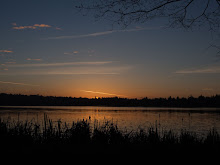After our visit with the conference president, Karin and I drove east to check out our parish. Instead of driving out the Long Island Expressway, we took Northern Boulevard so we could get a closer look at the communities of the area. The further we drove, the more impressed we were. I had no idea Long Island was so rich. The homes got larger and larger. It would be more descriptive to call them estates. Palatial homes set in expanses of lawn or nestled in forest. In places the highway skirted harbors filled with sail boats and yachts.
In Cold Spring Harbor, the last town before Huntington, we crossed a low spot where you could look north to Long Island Sound. On the right was a beautiful, small, Episcopal Church set next to an immense lawn and a lake populated with ducks and swans. The yard of the church was filled with people. A bride and groom were standing on the steps with the pastor in his robes.
It was an idyllic vision of quiet, long-term pastoral ministry. A shepherd and his flock. A ministry rooted in lasting, deep relationships. It was the polar opposite of the drama of urban ministry focused on a relentless drive to change neighborhoods, change political systems, rescue people from dramatically dysfunctional lives. But this, too, was ministry. The well-to-do and sophisticated needed Jesus, too. I could imagine becoming friends with these people, becoming part of the social fabric, being part of the life cycle of children, baptisms, weddings, marriage conflicts, funerals. Visiting people in the hospital, representing the face of Jesus in the ordinary patterns of life. Influencing through long-term relationships the shape of an entire community, not just a church.
We drove up the hill out of Cold Spring Harbor and, five miles later, into downtown Huntington. It was a real town. Main street was lined with shops. The sidewalks were filled with people. There were restaurants. We could see the harbor to the north filled with expensive boats. In the center of town we turned right on Highway 110 that ran south toward the Long Island Expressway and ultimately to the South Shore. As we drove, more shops, a book store, restaurants, then less glamorous businesses, an auto repair shop, a printer, a gas station. Then we came to the railroad station. It was surrounded by vast parking lots. We drove under the tracks. As the road came up on the other side, everything changed–drastically. Liquor stores, unkempt houses, a vacuum repair shop, a shoe repair shop, a convenience store. Weeds, trash.
At the corner of Ninth Street there was a bank. We turned right. Past the bank and a vacant lot. Then the church on the right. It was a simple white building with high steps that climbed steeply from the sidewalk. The parking lot was gravel and grass.
Across the street and down one lot was the parsonage. The house was squat and unattractive. It looked like the walls weren’t tall enough for the roof. The yard needed mowing. The bushes were overgrown. We drove around the immediate neighborhood. The parsonage blended right in. Some yards were well kept. Some were wrecks. The streets were filled with parked cars.
I was embarrassed by my disappointment. I had regarded myself as an enlightened liberal when it came to matters of class and race. I had dreamed of making a difference in the lives of poor people. Now here I was looking at a poor parish and dreaming of ministry a few blocks north.
I struggled to pull myself back down to earth. My parish was on this side of the tracks.
We drove to Babylon. Thirty-five minutes straight south. The church was one block south of the center of town and only two blocks from the water. The building looked run down. The gravel parking lot had huge potholes in it. My heart sank. This was not the ministry I had imagined. But it was my job starting January 1.
Tuesday, January 4, 2011
Subscribe to:
Post Comments (Atom)


No comments:
Post a Comment